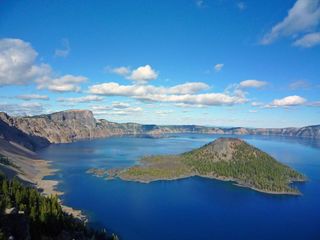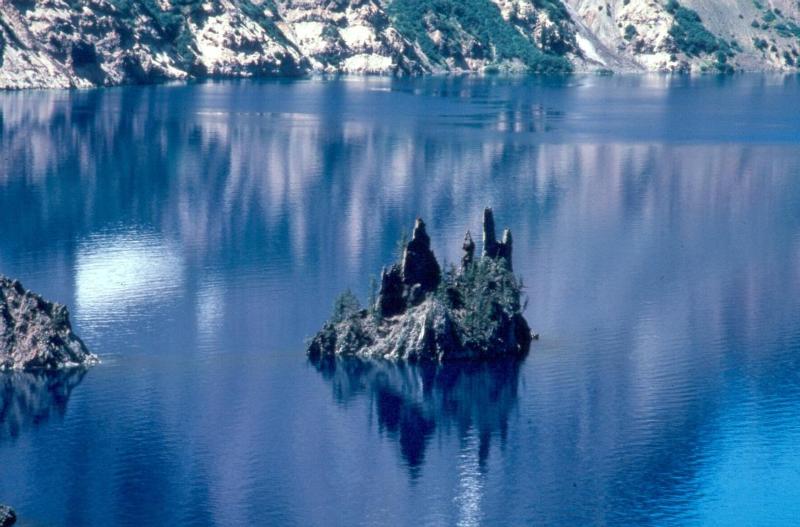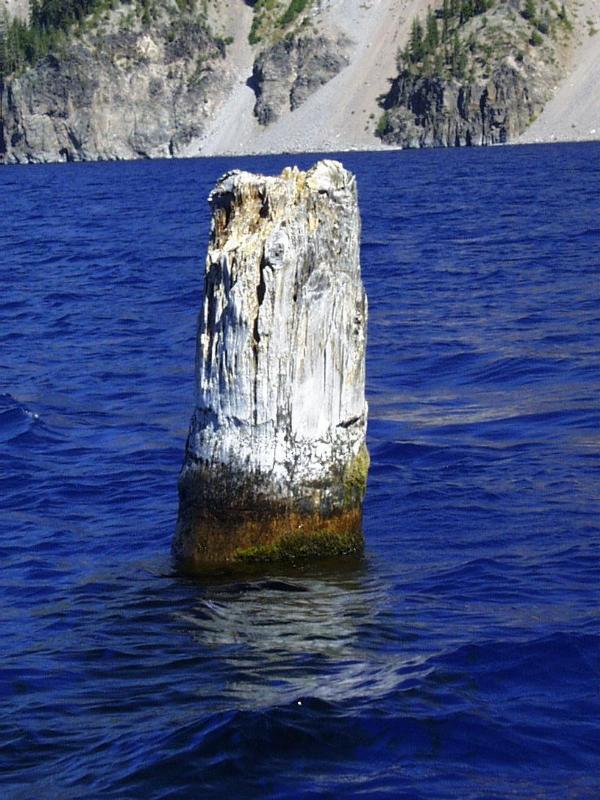Why Is the Water So Blue in Crater Lake
Crater Lake: Deepest Lake in U.S.

Crater Lake is the deepest lake in the United States. Located in Oregon, it is known for its vibrant blue color and purity. Because there are no inflowing streams, the lake is fed solely by rain and snow. It is the cleanest and clearest large body of water in the world, according to the National Park Service. Crater Lake National Park encompasses the lake.
Crater Lake is not a crater but an ancient caldera. Calderas are bowl-shaped depressions that form after a volcano erupts and expels most of its magma. Without the magma, the earth around the volcanic vent loses structural support and collapses inward, creating a bowl shape, according to National Geographic. A crater, in contrast, is the result of the earth around the volcanic vent exploding outward.
"Crater Lake is renowned because it is very accessible to geologists," said Ron Mastrogiuseppe, a naturalist and founder and president of the Crater Lake Institute. "The park becomes an outdoor classroom."
Dimensions
According to Crater Lake Trust and Crater Lake Institute, the following are dimensions for Crater Lake:
Surface area: 20.53 square miles, or 13,140 acres (53 square kilometers, or 5,317 hectares)
Maximum width: 4.97 miles (8 km)
Maximum length: 6.02 miles (9.69 km)
Maximum depth: 1,943 feet (592 meters). Crater Lake is the second-deepest lake in North America. Canada's Great Slave Lake is slightly deeper, said Mastrogiuseppe. Crater Lake is the seventh-deepest lake in the world.
Average depth: 1,148 feet (350 m)
Elevation at the lake's surface: 6,173 feet (1,1881 m)
Volume of water within lake: 5 trillion gallons (19 trillion liters)
National Park Size: 18,3224 acres (74,148 hectares)
History
Crater Lake is atop Mount Mazama, one of several now-dormant volcanoes, including Mount Saint Helens, in the Cascade Mountains. Mount Mazama is half a million years old and was once 12,000 feet high, according to Crater Lake Trust.
Crater Lake began to form around 5700 B.C. when Mount Mazama erupted, said Mastrogiuseppe. The eruption sent so much volcanic ash and pumice into the air that Mount Mazama's summit collapsed, leaving a massive, smoldering depression. Several smaller eruptions occurred, sealing the caldera floor. One of them left a cinder cone in the caldera. This would become Wizard Island.
Eventually, rain and snowmelt accumulated in the caldera, cooling it and forming Crater Lake. Animals, such as pika, deer, marmots, black bears, bobcats, hawks and eagles populated the area; and hemlock, firs, pine trees and wildflowers grew. This happened over millennia; "everything we see across the landscape today is the result of 7,700 years of change," emphasized Mastrogiuseppe.
In geologic time, Crater Lake is considered quite young. Humans probably witnessed the explosion, according to Crater Lake Trust. Scientists discovered a sandal and other artifacts in the layers of ash and pumice left after Mount Mazama's eruption. There are several Klamath stories about the creation of Crater Lake.
Crater Lake is part of the Klamath Native American tribal lands. The Klamath and other tribes did not tell explorers about it because it was considered sacred and a place for vision quests. To this day, some Native Americans do not look at Crater Lake because its sacred properties require the viewer to have great strength and power in order to gaze at it, according to the National Park Service.
Crater Lake was "discovered" by white miners in 1853, but since there was no gold there, it was soon forgotten. In 1862, another group of prospectors came upon the lake and published an article about it. Hostilities between Native Americans and settlers led to the construction of Fort Klamath and roads in the area. In 1865, the lake was again "discovered" by hunters on the road. This time, their tales brought visitors to the lake.
An Oregon transplant named William Gladstone Steel became enthralled with the lake and set about preserving it by establishing a national park. He advocated for Crater Lake for nearly 30 years and, in 1902 President Roosevelt signed legislation making Crater Lake the country's sixth national park, according to the National Park Service.

Features
Old Man of the Lake: A 30-foot-long hemlock log that floats upright in the lake. It has been bobbing in the blue waters for more than 100 years. About 4 feet of the log are visible above the water line. The Old Man of the Lake travels with the wind and waves and can be anywhere in the lake. Carbon dating has placed the log at about 450 years old, according to the National Parks Conservation Association. It has been suggested that that the clean, cold water has preserved the log and the balance between submerged and visible parts keeps the log floating.
Wizard Island: A large cinder cone that forms an island in the western end of Crater Lake. The summit of Wizard Island is 763 feet above the water and the island is about 1 square mile, according to Crater Lake Institute. A 500-foot wide crater, named the Witches Cauldron by William Gladstone Steel, is at the summit of the island's cone. It is possible to take a boat to Wizard Island and hike around the crater. Raw-looking lava flows are visible on the island.
Phantom Ship: A small island in the southeast end of Crater Lake. It is made of 400,000-year-old andesite rock spires shaped from hydrothermal activity in the lake. It is about 500 feet long and 200 feet wide, according to Crater Lake Institute, and the tallest spires tower 170 above the water. It gets its name from its spires and the gray color of the stone, which cause the island to resemble a ghost ship in the fog. Despite its seemingly harsh appearance, various pine trees grow on the island.
Feeders: No inflowing streams feed Crater Lake. Instead, about 78 percent of the water in the lake comes from precipitation; Crater Lake gets about 44 feet of snow each year (it rarely freezes, however). Additionally, water from glacial springs flows into the lake, according to the Crater Lake Institute.
There are no direct outlets from the lake. About 30 percent of the lake's water loss is caused by evaporation; the rest is from seepage. The water seeps through glacial and volcanic debris into the earth. Some of the water reappears in springs at lower elevations, according to Mastrogiuseppe.
Water purity: Crater Lake is famous for its water purity, with only 79 (toxic) particles per million, said Mastrogiuseppe. The purity is attributed to the lake's youth and the absence of inflowing streams that introduce debris and other minerals. Additionally, the volcanic rocks on the lake walls and floor and relatively insoluble in the lake's cold waters.
The lake's purity has restricted the growth of aquatic life; for instance, there is not enough calcium for large shelled animals to develop. Rainbow trout and kokanee salmon live in the lake but they are not native. Moss, however, thrives in the clear water and grows at depths of 60 to 425 feet (18 to 129.5 m). It does not grow that deep anywhere else in the world, according to Mastrogiuseppe.
Color and clarity: The lack of pollutants contributes to the lake's extremely clear water, according to the National Park Service. Light penetrates 40 meters (131 feet) down into the lake, which exceeds the usual 20 to 25 meters (65.6 to 82 feet) of light penetration in alpine lakes.
Crater Lake's deep blue color is caused by the lake's depth, clarity, purity and the way that solar radiation interacts with the water, according to the National Park Service. Water molecules absorb red, orange, yellow and green wavelengths of light but scatter blue ones. In very deep water, these blue wavelengths of light are often redirected up to the surface, where they are visible and contribute to the lake's intense color.
Hydrothermal vents: According to National Geographic, unmanned submarine expeditions have determined that there are hydrothermal vents on the lake's bottom. Scientists are still working to understand this element of the lake's geology.

Concerns
Crater Lake faces several threats, including atmospheric pollution, climate change, human overuse and invasive species.
"The challenge with pristine lakes is to protect the purity of the water," said Mastrogiuseppe. The lack of tributaries, which contributes to Crater Lake's purity, also makes it especially vulnerable to pollution. When pollutants are introduced, they don't have many places to go.
Pollutants are introduced through air pollution and toxic particles in rain and snow, litter left by visitors and gas-powered boats that take visitors to Wizard Island. Crater Lake Institute considers pollution from the boats a "potential if not actual threat." Naturalists have worked to protect Crater Lake from pollutants brought by Rim Village, a settlement in the National Park. "The old lodge had a large septic tank near the rim and threatened to contaminate the lake," said Mastrogiuseppe. To prevent sewage from contaminating the lake, a sewer was built to take waste away from the lake area.
Climate change poses a danger to Crater Lake. According to the National Park Service, climate change has led to decreased snowfall at Crater Lake, warming of the lake's waters and problems for flora and fauna. Less snowfall means that pollutants become denser in the lake, as it is not replenished. Additionally, less water seeps into the earth and, therefore, less of it eventually makes its way to springs that provide water to forests, ranches and cities.
Since 1965, Crater Lake's waters have warmed approximately 1 degree Fahrenheit every decade. Scientists are still determining the effect this will have on the lake's ecosystem. Some experts suspect that more and potentially different algae will grow in the water, reducing the water's clarity, according to the National Park Service.
Warming temperatures are damaging Crater Lake's pika population. The small mammals cannot survive in warm climates, and several communities around Crater Lake have already disappeared, according to the National Park Service.
Whitebark pines are a keystone species at Crater Lake, meaning that many other species depend on them for shelter, food and survival, according to the National Park Service. The mountain pine beetle is a threat to these trees. The beetles can inflict serious damage but can only live in warm climates. Historically, Crater Lake's chilly climate has protected whitebark pines from the beetles, but since temperatures have warmed, the beetles have attacked the trees. Currently half the whitebark pines at Crater Lake are dead or dying.
Crater Lake National Park attracts thousands of visitors each year, and they can cause damage to the environment. In addition to littering, visitors can harm underbrush and shrubbery and disrupt wildlife with noise and intrusion, according to Trails.com. Visitors can also introduce invasive species to the lake. In 2012, the National Park Service temporarily closed Crater Lake to scuba divers because they brought foreign bacteria into the lake's waters. Such invasive species can have a devastating effect on ecosystems.
Volcanic future
"Cascadian Volcanism remains a possibility," said Mastrogiuseppe. "The future may see the destruction of Crater Lake as we know it today." An event as large as Mount Mazama's eruption is unlikely, but smaller events could still wreak havoc. A volcanic eruption would probably happen underwater, which would increase the power of the explosion because of the mix of magma, hot rock and water. If a volcanic event occurred, the caldera walls could fail and cause serious flooding.
Scientists have not found evidence to suggest that volcanic activity at Crater Lake is imminent, according to the National Park Service. There has been no volcanic activity at the site in 5,000 years and there is no evidence of magma movement beneath the caldera floor's surface. Additionally, no earthquakes, which are typically associated with volcanic activity, have been reported.
Additional resources
- NPS: Crater Lake National Park
- Crater Lake Institute
- Crater Lake Trust
Source: https://www.livescience.com/56796-crater-lake.html#:~:text=Crater%20Lake's%20deep%20blue%20color,light%20but%20scatter%20blue%20ones.
0 Response to "Why Is the Water So Blue in Crater Lake"
Post a Comment